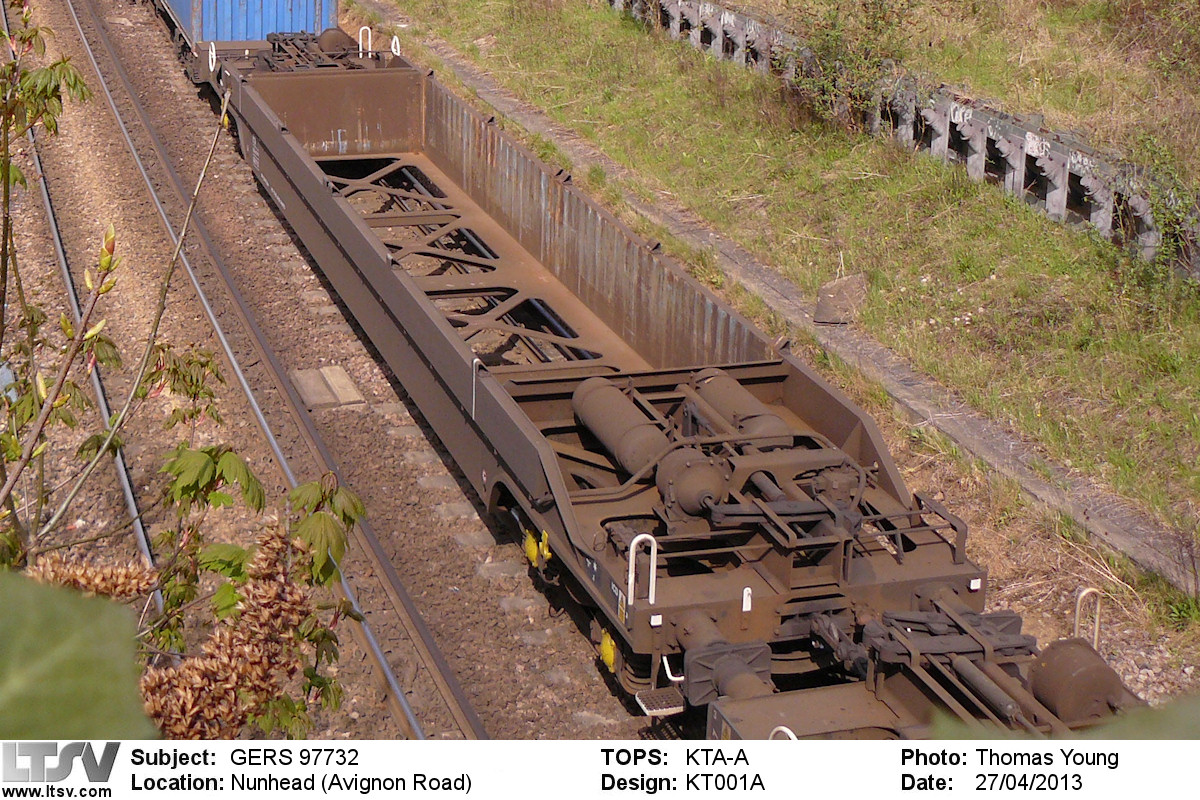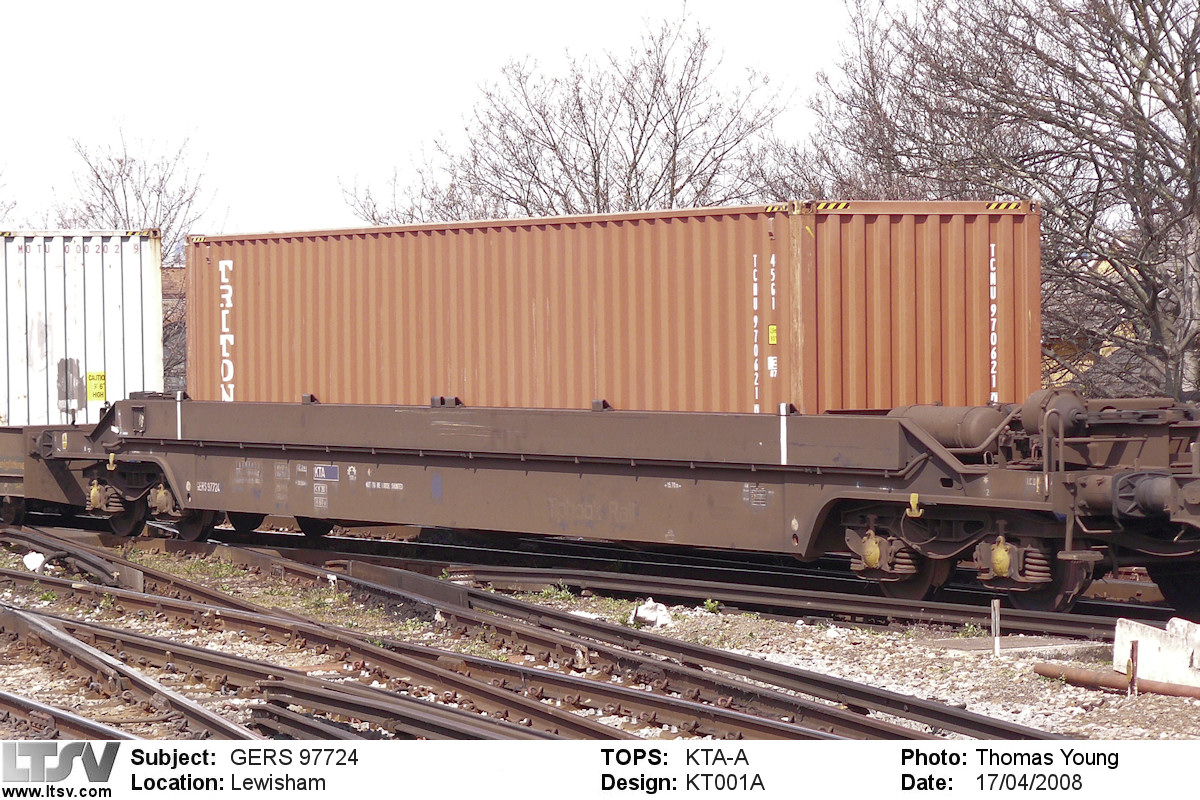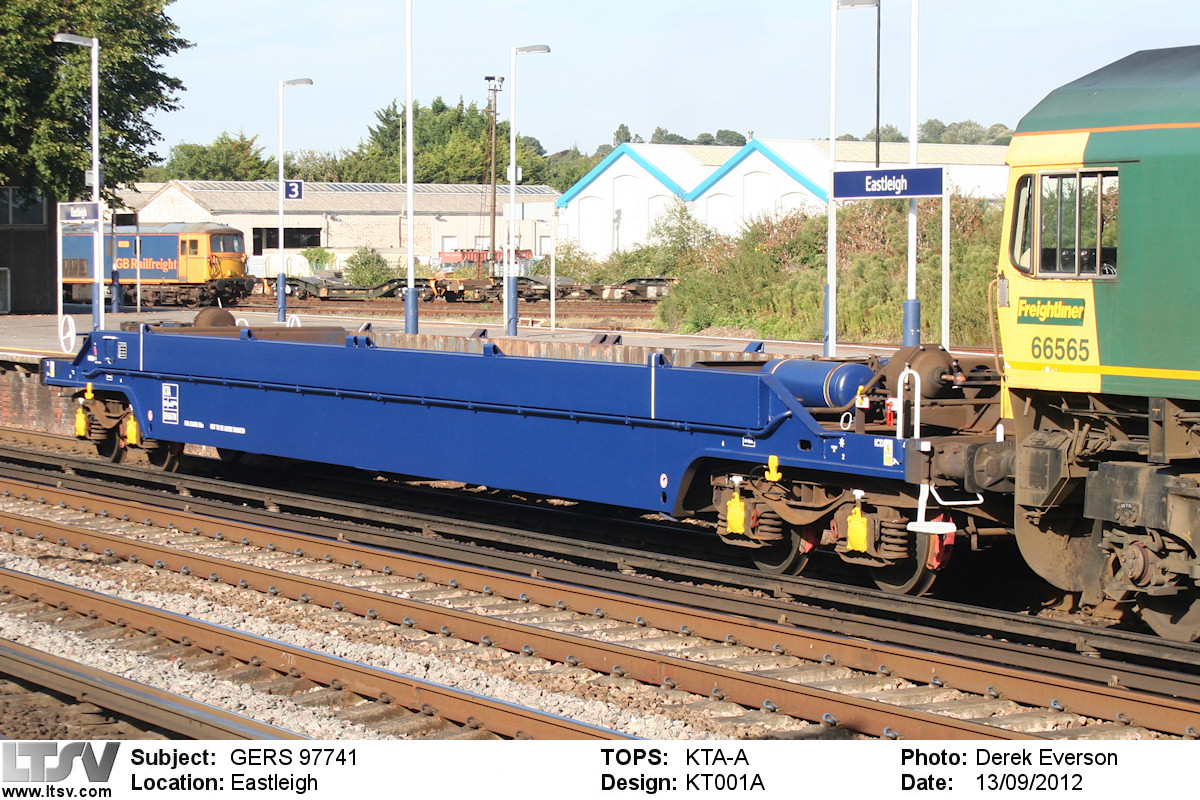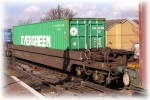| << Profile 55 >> |
KQA/KTA Tiphook 'Pocket' Container Wagons |
  
| Build Details: |
1997-1998 by Rautaruukki, Finland |
| Numbering: |
GERS97700-97774 (originally 84.70.4907.000-074) |
| Bogies / Suspension: |
Y25C |
| Dimensions: |
|
| Published Drawings: |
|
| Areas of operation: |
Main-lines |
| Main liveries: |
Dark blue |
| Summary: |
The KQA/KTA wagons were another type specifically intended to permit the carriage of 9ft 6in tall containers within the UK loading gauge. With a distinctive slab-sided design, the wagons were initially given RIV numbers, but being used only on domestic Freightliner services, were later renumbered into the private-owner series. The method of carrying containers earned them the nickname Pocket wagons. |
|
| History: |
As has been mentioned before, the growing use of 9ft 6in tall containers caused problems for UK railfreight operators, since such boxes could not be conveyed within the loading gauge on conventional container flat wagons. Besides various low-deck, small-wheeled designs, a further solution appeared in 1997 in the form of Tiphook's 'Pocket' wagon. As the name suggests, these wagons carry the container in a 'pocket' formed by mounting a deck low between the bogies, with the sides of the wagon built up to provide much of the strength. The actual floor is an open lattice framework while the sides are relatively solid and flat, being raised above the normal floor height between the bogies. The result is a curious slab-sided appearance which is unique among intermodal wagons. Another unusual feature of the type is that it has a usable length of just 40ft, the remainder being accounted for by the bogies. As such, they can carry a single 40ft container or two 20ft containers. Locating spigots are fitted at the outer end of the pocket floor, the wagon sides holding the containers in place. The brake operating gear and air cylinders are mounted above the bogies at opposite ends.
 | KTA GERS97732 was photographed at Nunhead in April 2013. This high-level view shows the 'pocket' with its open framework floor and solid sides, and also the brake equipment carried over the bogies. |
An initial batch of 35 wagons was built by Rautaruukki in Finland in 1997, the first arriving in the UK in September. This batch used Y25C bogies recovered from Tiphook KPA aggregate hoppers that were scrapped due to a downturn in work for them. Finishing work, including fitting the bogies, was carried out by Marcroft Engineering at Horbury. Coded KQA (KQA-A) to design code KQE849, the wagons were numbered in the international series as 33.70.4907.000 to 33.70.4907.034 [1]. It would appear that the RIV exchange code was changed to 84 at some point, perhaps from as early as the second wagon. This presumably reflected the fact that the wagons were not intended to routinely work to the continent.
The livery carried was Tiphook dark blue, with plentiful lettering (numbering, Tiphook logo and operating instructions) on the slab sides. The wagons were hired to Freightliner and entered service, initially between Coatbridge and Grain, in early 1998.
A repeat order was placed in 1998 for an additional 40 identical wagons [2], these using new-build bogies. This took the number series up to 074, but the exchange code used is once again unclear, photographic evidence suggesting that they were 84.70.4907.xxx while published sources give 33.70.4907.xxx [3]. This batch was also hired to Freightliner, and the wagons became a common site in rakes mixed with other types such as the FSA/FTA, FLA and (later) FEA.
After five years of use, it was decided that the wagons should be renumbered to reflect their domestic-only use. From about mid-2003, the whole fleet was progressively renumbered in the private owner series as GERS97700 to GERS97774, retaining the last two digits from their former RIV numbers [4]. The new owner prefix of GERS followed the takeover of Tiphook by GE Rail Services. At the same time the TOPS code was changed to KTA (KTA-A to design code KT001A), although the last wagon was not altered until 2006.
The 'pocket' wagons are notable for often operating in a filthy state. The original Tiphook blue livery is more often than not completely hidden by a coating of grime, especially on the flat wagon sides. The lettering patches are sometimes wiped clean but it is not untypical for the new TOPS codes and numbers to be the most visible, suggesting that the wagons have not been cleaned since they were renumbered.
| KTA GERS97724 at Lewisham in 2008 retains most of the extensive original lettering. The Tiphook logo in particular is almost lost beneath the grime, while would you guess the livery of this wagon was actually blue? |  |
From early 2012 the KTA wagons started being dispatched to Arlington Fleet Services at Eastleigh for overhaul [5]. The work included a repaint in blue livery, but it appears that this just extends to the wagon's slab sides. The inside of the 'pockets', and the platforms and equipment above the bogies, are left untreated. As well as being generally cleaner, the overhauled wagons can be identified by having much sparser lettering.
 | Fresh from overhaul at Eastleigh, KTA GERS97741 shows the minimal lettering now carried. Note also that the repaint doesn't go far beyond the wagon sides. |
|
|
| Queries: |
|
|
| References: |
1. ^ Rail Express magazine, issue 19 (December 1997), p.51
2. ^ Rail Express magazine, issue 24 (May 1998), p.56
3. ^ Rail Express magazine, issue 27 (August 1998), p.55
4. ^ Rail Express magazine, issue 88 (September 2003), p.36
5. ^ Rail Express magazine, issue 191 (April 2012), p.55
|
|
| Links: |
Photos of KTA wagons on Martyn Read's website
Photos of KTA wagons on Andy Jupe's website
|
|
| Updates: |
04/04/2013: Photo links (finally) updated.
15/10/2014: Note on overhauls added, along with new photos and references.
|
|
| Photos |
| For more pictures see the Links section at the bottom |

KTA GERS97755 in typically dirty condition at Lewisham, 26th February 2008. Note the yellow/black markings at the top corners of the 9ft 6in containers.
Thomas Young
|
|









